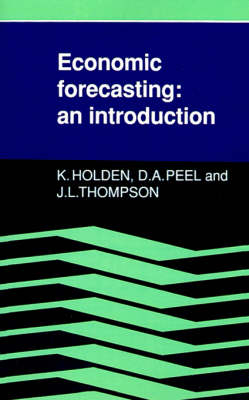
Economic Forecasting
An Introduction
Seiten
1991
Cambridge University Press (Verlag)
978-0-521-35692-3 (ISBN)
Cambridge University Press (Verlag)
978-0-521-35692-3 (ISBN)
This book provides an introduction to the methods employed in forecasting the future state of the economy. It is the only text currently available which provides a comprehensive coverage of methods and applications in this fast-growing area.
This book provides an introduction to the methods employed in forecasting the future state of the economy. It provides a comprehensive coverage of methods and applications in this fast-growing area and is intended for use in postgraduate and upper-level undergraduate courses. Part I outlines the available techniques, particularly those used in business forecasting and econometric forecasting. The state of the art in time series modelling is reviewed and includes a discussion of Box-Jenkins models, the vector autogressive approach and cointegration. Ways of combining forecasts are also examined in detail. Part II considers the most important applications of forecasting. Applications in microeconomics include demand and sales forecasting, the use of anticipations data, leading indicators and scenario analysis. In macroeconomics the emphasis is on why errors occur in forecasting asset market prices, including implications of the efficient markets hypothesis for foreign markets, stock market prices and commodity market prices. The book ends with a discussion of the appropriateness of various techniques, recent developments in forecasting, and the links between economic forecasting and government policy.
This book provides an introduction to the methods employed in forecasting the future state of the economy. It provides a comprehensive coverage of methods and applications in this fast-growing area and is intended for use in postgraduate and upper-level undergraduate courses. Part I outlines the available techniques, particularly those used in business forecasting and econometric forecasting. The state of the art in time series modelling is reviewed and includes a discussion of Box-Jenkins models, the vector autogressive approach and cointegration. Ways of combining forecasts are also examined in detail. Part II considers the most important applications of forecasting. Applications in microeconomics include demand and sales forecasting, the use of anticipations data, leading indicators and scenario analysis. In macroeconomics the emphasis is on why errors occur in forecasting asset market prices, including implications of the efficient markets hypothesis for foreign markets, stock market prices and commodity market prices. The book ends with a discussion of the appropriateness of various techniques, recent developments in forecasting, and the links between economic forecasting and government policy.
Part I. Techniques: 1. Introduction to forecasting methods; 2. Time series methods; 3. Combination of forecasts; Part II. Applications: 4. Microeconomic forecasting; 5. Macroeconomic forecasting; 6. Forecasting asset market prices; 7. Conclusions.
| Erscheint lt. Verlag | 4.4.1991 |
|---|---|
| Zusatzinfo | 2 Line drawings, unspecified |
| Verlagsort | Cambridge |
| Sprache | englisch |
| Maße | 152 x 229 mm |
| Gewicht | 340 g |
| Themenwelt | Wirtschaft ► Volkswirtschaftslehre ► Ökonometrie |
| Wirtschaft ► Volkswirtschaftslehre ► Wirtschaftspolitik | |
| ISBN-10 | 0-521-35692-X / 052135692X |
| ISBN-13 | 978-0-521-35692-3 / 9780521356923 |
| Zustand | Neuware |
| Informationen gemäß Produktsicherheitsverordnung (GPSR) | |
| Haben Sie eine Frage zum Produkt? |
Mehr entdecken
aus dem Bereich
aus dem Bereich
Nachhaltigkeit und Megatrends
Buch | Softcover (2025)
De Gruyter Oldenbourg (Verlag)
CHF 55,90
Übungsaufgaben – Fallstudien – Lösungen
Buch | Softcover (2022)
De Gruyter Oldenbourg (Verlag)
CHF 34,90
Set aus Lehr- und Arbeitsbuch
Buch | Softcover (2022)
De Gruyter Oldenbourg (Verlag)
CHF 49,95


